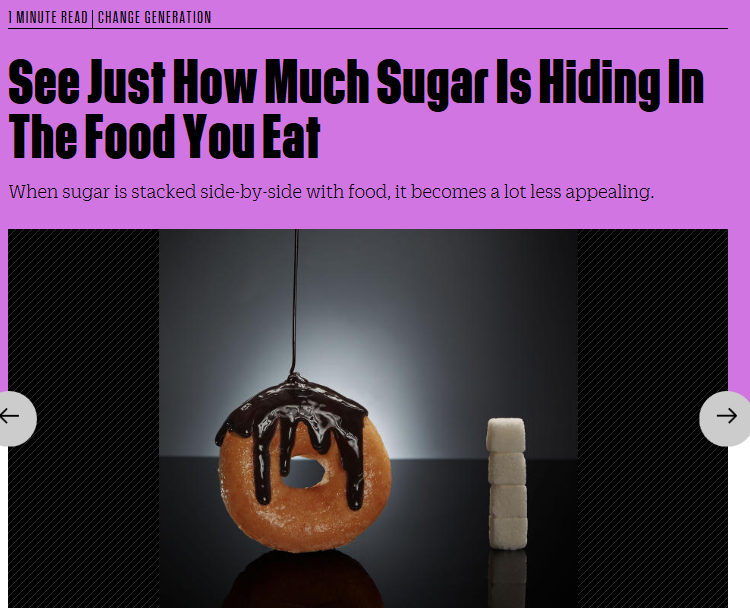how much sugar is hiding in the food you eat
FastCo
Charlie Sorrel 01.17.17 6:00 AM
Sin Azucar, or “without sugar,” is a photographic project from Spanish photographer Antonio Rodríguez Estrada. The idea is as simple as can be: Estrada takes packaged foods and photographs them alongside the amount of sugar they contain. The results speak for themselves, and are often—especially in the case of supposedly savory foods—quite surprising.
Estrada’s images need no explanation, and are perfect for sharing on social media. In fact, the photographer encourages doing just that, as a way to raise awareness of just how much sugar is contained in processed foods. Most people would guess that a Coke or a candy bar is stuffed full of sugar, but what about curry mango sauce (nine cubes)? or Caesar salad dressing (six cubes)?
The surprises continue. A pizza has four and a half cubes; bread has almost a cube per slice. How much sugar might you find in a Nestlé yogurt for a baby? A yogurt marked as “natural,” which in Spain, where Estrada is from, means that it has no added flavor? One container hides two and a half cubes.
Estrada says that he uses the same visual language that the industry uses to sell its products—”neat lighting, attractive retouching, visual impact, etc.”
In the U.S., around 60% of packaged foods and drinks found from the average grocery store contain added sugar, according to a new study from researchers at the University of North Carolina. And just looking at the ingredients label isn’t enough, because manufacturers often try to disguise the added sugar by giving it another name: high-fructose corn syrup, evaporated cane juice, rice syrup, and flo-malt are all popular ingredients that are effectively just sugar.
The answer? Well, you can share these images, but best of all is probably to avoid eating too many processed foods, and to assume that any food or drink that has been prepared for your convenience has also been pumped full of sugar. Or just stick to a diet made up exclusively of Coke and candy bars—at least you’ll know where you stand.
related posts
-
Sugar High: Study Shows Kids Consume too much Added Sugars
Food Business News came out with a staggering statistic that sugar makes up 16% of American kids’ calorie intake. Research has shown that added sugars are most commonly found in soda which of course provides no nutritional benefit. While food items like nuts and fruit contain sugar, this type of sugar is naturally occurring and [...]
-
Economics of Food Prices
Kelly Brownell in the Wall St Journal points out that today "healthy foods cost more and calorie-dense processed and fast foods cost less." This is partly because of subsidies to high fructose corn syrup and other sugar-laden and corn-derived industries. It is also because healthful foods without preservatives may not have as long shelf-lives as [...]
-
How the sugar industry has distorted health science for more than 50 years
The sugar industry has a long history of shaping nutrition policy in the United States, working to mask the potential risks of consuming too much of the sweet stuff. It wasn’t until this year, for instance, that the US Dietary Guidelines finally recommended people keep their consumption of added sugars below 10 percent of their [...]
-
Unhealthy Food, Unhealthy Brains for Kids
A recent article in Baby Center illustrates the dangers of feeding children unhealthy foods, in contrast to favorable nutrition which fosters brain function growth and cognitive ability. Although unhealthy options may sometimes be the easier one choice, they are seemingly very problematic down the road. Spotted by Daniel Lubetzky, redacted by Adeena Schlussel BabyCenter [...]
-
How the Sugar Industry Shifted Blame to Fat
By ANAHAD O’CONNOR The sugar industry paid scientists in the 1960s to play down the link between sugar and heart disease and promote saturated fat as the culprit instead, newly released historical documents show. The internal sugar industry documents, recently discovered by a researcher at the University of California, San Francisco, and published Monday in [...]














Comments are closed.